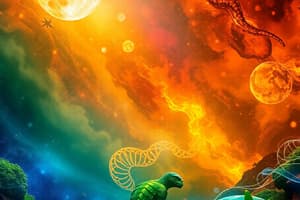Podcast
Questions and Answers
Evolution is a theory about the origin of life.
Evolution is a theory about the origin of life.
False (B)
What is Abiogenesis?
What is Abiogenesis?
Processes that led to the origin of life.
Evolution is a climb up the ladder of progress.
Evolution is a climb up the ladder of progress.
False (B)
Evolution is entirely random.
Evolution is entirely random.
Natural selection involves organisms trying to adapt.
Natural selection involves organisms trying to adapt.
What is Lamarck's view on evolution?
What is Lamarck's view on evolution?
Evolution is just a theory.
Evolution is just a theory.
Which of the following is evidence for evolution?
Which of the following is evidence for evolution?
What did Darwin not know?
What did Darwin not know?
Similar structures in different species show common ______.
Similar structures in different species show common ______.
What are the 5 mutation effects?
What are the 5 mutation effects?
What is the term for measure of population variation at a single locus?
What is the term for measure of population variation at a single locus?
What is Adaptive Evolution?
What is Adaptive Evolution?
What is the result of nonrandom mating/inbreeding?
What is the result of nonrandom mating/inbreeding?
What is the key factor of Biological Species?
What is the key factor of Biological Species?
Which of the following is NOT a Prezygotic Barrier?
Which of the following is NOT a Prezygotic Barrier?
List the 3 Postzygotic Barriers.
List the 3 Postzygotic Barriers.
What occurs during Allopatric Speciation?
What occurs during Allopatric Speciation?
During Sympatric Speciation, what is the cause of genetic divergence?
During Sympatric Speciation, what is the cause of genetic divergence?
What does Phylogenetic Tree represent?
What does Phylogenetic Tree represent?
What does it mean to be Paleozoic?
What does it mean to be Paleozoic?
Which of the following is a characteristic of the Cambrian period?
Which of the following is a characteristic of the Cambrian period?
Name the 3 eras that the current geological exon is split into.
Name the 3 eras that the current geological exon is split into.
Flashcards
Evolution Definition
Evolution Definition
Evolution explains how life changes after its origin, not the origin of life.
Abiogenesis
Abiogenesis
Processes that led to the origin of life from non-living matter.
Natural Selection
Natural Selection
Survival of individuals with favorable traits that reproduce more successfully.
Lamarck's Theory
Lamarck's Theory
Signup and view all the flashcards
Vestigial Structures
Vestigial Structures
Signup and view all the flashcards
Fossil Record
Fossil Record
Signup and view all the flashcards
Genetic Variation
Genetic Variation
Signup and view all the flashcards
Mutation
Mutation
Signup and view all the flashcards
Hardy-Weinberg Equilibrium
Hardy-Weinberg Equilibrium
Signup and view all the flashcards
Genetic Drift
Genetic Drift
Signup and view all the flashcards
Speciation
Speciation
Signup and view all the flashcards
Biological Species Concept
Biological Species Concept
Signup and view all the flashcards
Allopatric Speciation
Allopatric Speciation
Signup and view all the flashcards
Parapatric Speciation
Parapatric Speciation
Signup and view all the flashcards
Sympatric Speciation
Sympatric Speciation
Signup and view all the flashcards
Prezygotic Barriers
Prezygotic Barriers
Signup and view all the flashcards
Postzygotic Barriers
Postzygotic Barriers
Signup and view all the flashcards
Hadean Eon
Hadean Eon
Signup and view all the flashcards
Archean Eon
Archean Eon
Signup and view all the flashcards
Proterozoic Eon
Proterozoic Eon
Signup and view all the flashcards
Phanerozoic Eon
Phanerozoic Eon
Signup and view all the flashcards
Paleozoic Era
Paleozoic Era
Signup and view all the flashcards
Mesozoic Era
Mesozoic Era
Signup and view all the flashcards
Cenozoic Era
Cenozoic Era
Signup and view all the flashcards
Heterochrony
Heterochrony
Signup and view all the flashcards
Homology
Homology
Signup and view all the flashcards
Cladograms
Cladograms
Signup and view all the flashcards
Phylogenetic Tree
Phylogenetic Tree
Signup and view all the flashcards
Principle of Maximum Parsimony
Principle of Maximum Parsimony
Signup and view all the flashcards
Taxonomy
Taxonomy
Signup and view all the flashcards
Study Notes
Evolution
- Evolution is a theory about the origin of life, focusing on how life changes after its origin, not how it began.
- Abiogenesis describes the processes that led to the origin of life.
- Scientific hypotheses suggest a gradual transition from non-living to living, with key steps including the prebiotic synthesis of small organic molecules, molecular self-replication, and self-assembly.
- Evolution is not a climb up a ladder of progress; it's about reproductive fitness, not about progress.
- Natural selection eliminates individuals with lower reproductive success in a given environment.
- Many existing species (e.g., mosses, fungi, corals) have changed little over extended periods, illustrating this point.
- Evolution is not entirely random; random mutations are the source of genetic variation, but the evolutionary change is limited by environmental factors.
- Only heritable variations that improve population fitness persist, through the process of natural selection.
- Natural selection is not about organisms trying to adapt; it's about the persistence of favorable traits.
- Lamarck's ideas of "use and disuse" and "inheritance of acquired characteristics" are incorrect as traits are passed through genes, not acquired.
- Natural selection doesn't give organisms what they need; it favors those traits that promote survival and reproduction.
- Evolution is not about intent; it is the consequence of genetic variation and environmental pressures.
Evolution of Populations/Microevolution
- Mutation is a source of genetic variation.
- A single mutation can have various effects (neutral, deleterious, lethal, advantageous).
- Sexual reproduction creates new allele combinations through recombination and independent assortment during meiosis.
- Fertilization further increases variation through the random fusion of gametes.
- Heterozygosity (H) measures population variation at a single locus.
- Average Heterozygosity (Havg) represents overall variation across multiple loci, which is needed for a full understanding.
- Hardy-Weinberg Equilibrium describes a population where allele frequencies remain constant across generations, essentially no evolution is occurring.
Factors Disrupting Hardy-Weinberg Equilibrium
- Genetic variation through mutations
- Gene flow (immigration/emigration)
- Population size (genetic drift)
- Natural selection
- Nonrandom mating (inbreeding)
Speciation
- Speciation rates may be slow or rapid.
- Allopatric speciation occurs when populations are geographically isolated, thus preventing gene flow.
- Parapatric speciation occurs in a continuous habitat with strong environmental gradients and selection favoring different alleles on either side of the gradient.
- Sympatric speciation is the emergence of newspecies without geographical isolation.
History of the Earth
- Hadean Eon (4.6-4.0 billion years ago): Formation of Earth, Moon; Earth's layer differentiation; early atmosphere.
- Archean Eon (4.0-2.5 billion years ago): Oldest known rock formations, high heat flow, intense volcanic activity; abiogenesis (origin of life).
- Proterozoic Eon (2.5 billion - 541 mya): Great Oxygenation Event; formation of the ozone layer; first major glaciations; endosymbiosis led to compartmentalized cellular structures (eukaryotes).
Biological impact of evolution
- Biological processes impact organisms in many ways, including reproduction, and environmental factors.
- Environmental changes can affect a species or population in many ways, such as affecting the likelihood of speciation.
Studying That Suits You
Use AI to generate personalized quizzes and flashcards to suit your learning preferences.
Related Documents
Description
Explore the theory of evolution, focusing on how life changes and the role of natural selection. Understand the importance of reproductive fitness and how environmental factors limit evolutionary change. Learn about the origin of life from non-living things via Abiogenesis.





